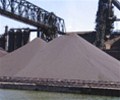The Mærsk Mc-Kinney Møller Center for Zero Carbon Shipping (MMMCZCS) and the Italian classification society RINA submitted comments to the IMO about ammonia safety on ammonia-fuelled ships. The International Maritime Organization (IMO) is working on draft interim guidelines for using ammonia as a fuel on ships. The final draft of these guidelines is expected to be reviewed and approved by the IMO’s Maritime Safety Committee (MSC) in December, Engine reported.
MMMCZCS and RINA have submitted a joint report to help develop these guidelines for the safe handling and storage of ammonia on ammonia-powered vessels.
Ammonia bunker stations and fuel preparation rooms are the most susceptible to ammonia leaks, they argue. There is also a high risk of ammonia leaks from fuel tanks, fuel piping, vent mast, ventilation outlets and reliquification systems.
Places where ammonia is handled on ships, including bunkering equipment and fuel storage rooms, must have gas detection alarms.
MMMCZCS and RINA cite varying views on what the minimum level of ammonia leak should be to trigger a gas detector alarm. These minimum ammonia concentrations range between 30-220 parts per million (ppm).
The IMO should determine the exact minimum limit based on recommendations from classification societies, they say.
MMMCZCS and RINA’s estimates are based on suggestions from eight classification societies and the International Association of Classification Societies (IACS).
The American Bureau of Shipping (ABS) recommends that gas alarms and gas evacuation systems should be triggered when the ammonia concentration in a space exceeds 150 ppm.
Lloyd’s Register (LR) and the China Classification Society (CCS) both suggest that a much lower concentration level of 25 ppm should trigger alarms and evacuation systems, while Bureau Veritas (BV) recommends just 10 ppm.
DNV, RINA, Korea Register (KR) and ClassNK have not specified a specific level at which the alarm should be triggered.
ABS, CCS, DNV and KR suggest that ammonia concentrations exceeding 300 ppm should trigger an emergency shutdown of a ship. LR has suggested 230 ppm, and BV recommends 30 ppm as the shutdown level. ClassNK, RINA and IACS have not suggested any shutdown level.
“In the absence of a common understanding on toxicity level limits when it comes to ammonia, classification societies and flags are applying varying limits, which renders the design of new technologies cumbersome and costly,” they write to the IMO.
Water curtains or sprays should be located in bunker areas on ships and by fuel storage tanks, they argue. And the IMO should define the differences between safe and toxic areas more clearly.
There should be secondary barriers to prevent ammonia gas from escaping in areas where ammonia is held.
“These system designs must ensure that bilge drainage does not lead to locating pumps in safe spaces, thereby maintaining separation from potential ammonia risks,” they suggest.
The bilge is the lowest part of a ship’s interior. This part of the ship usually accumulates water, oil and other waste fluids when they leak or condensate. This can be runoff from the deck or even happen naturally when the ship moves.
MMMCZCS and RINA call on the IMO to establish guidelines for how to dispose of bilge waste in case of ammonia contamination.
And they also urge the IMO to work to broaden our understanding of how ammonia impacts the environment and how cold ammonia behaves in the sea.
Source: Port News





